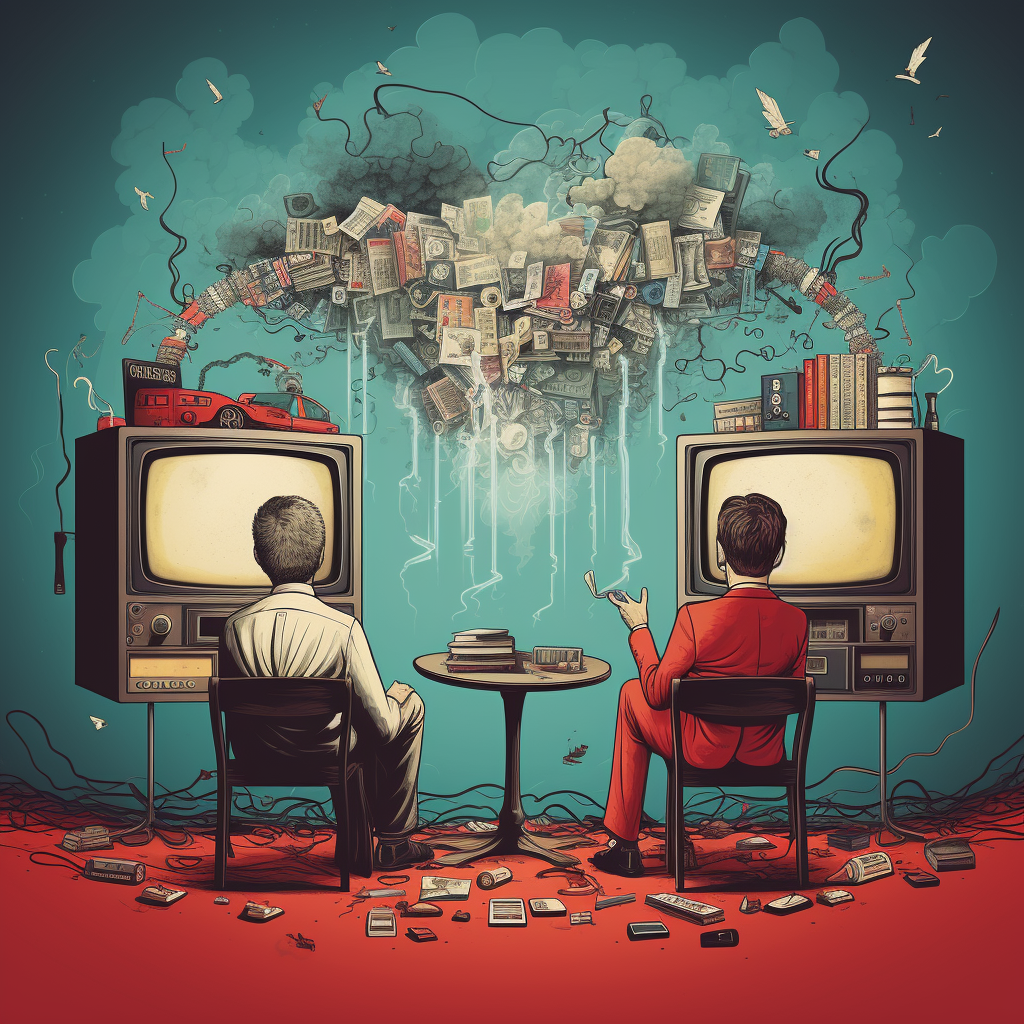
The Evolution of Smoking's Portrayal on Television
Introduction: Setting the Scene with a Puff
Have you ever observed the protagonists of your cherished television series igniting a cigarette in the midst of a dimly illuminated room? This seemingly deliberate act is no mere coincidence. Smoking, particularly within the realm of television series, emerges as a powerful instrument wielded to delineate characters, cultivate atmospheres, and even offer nuanced social reflections. Delving into this intriguing interplay between cigarettes and the screen, we uncover a smoky tapestry that weaves characters and narratives into a richly textured visual experience.
Smoking's portrayal within television series transcends mere plot points—it's a cinematic brushstroke that shapes character identities. The act of lighting a cigarette, its inhalation and exhalation, speaks volumes about a character's disposition, inner turmoil, or aspirations. This visual language becomes a silent monologue, allowing viewers to glimpse into the depths of a character's psyche. Whether it's an emblem of introspection or an assertion of defiance, smoking crafts a non-verbal dialogue that endows characters with layers of authenticity and complexity.
Beyond individual character arcs, smoking assumes a broader narrative role by setting moods and echoing social commentary. The tendrils of smoke drifting across the screen can evoke a sense of intrigue, mystery, or melancholy, painting emotional landscapes that resonate with the viewers. Moreover, the portrayal of smoking can serve as a barometer of societal norms and changes. In periods where smoking was glamorized, characters who smoked projected an air of sophistication and allure. In contrast, as societal attitudes shifted towards health consciousness, smoking could signal vulnerability, rebellion, or even moral ambiguity. By deftly integrating smoking into the visual narrative, television series harnesses the power of this simple yet potent act to reinforce thematic nuances, mirror cultural shifts, and sculpt multi-dimensional stories that unfold through both words and visuals.
In conclusion, the convergence of cigarettes online and television creates a symbiotic relationship that extends beyond aesthetics. Smoking within television series functions as an artistic device that sketches character nuances, illuminates emotional landscapes, and mirrors societal dynamics. The plumes of smoke become a canvas on which characters paint their inner struggles, aspirations, and complexities. They whisper stories and breathe life into narratives, inviting audiences into a world where every puff of smoke holds a narrative potential that transcends the confines of words.
The Golden Era: Smoking as the Norm
Transporting back to the 1950s and '60s unveils a television landscape that epitomized the golden age of the medium. Within this era, smoking transcended its status as a mere action and evolved into an accepted societal norm. A contemporary lens onto that era, as offered by shows like "Mad Men," provides a retrospective window into the past. During those times, characters spanning diverse backgrounds would frequently light up cigarettes, imbuing the act with a sense of refinement and elegance. The swirls of native smoke that enveloped screens served as visual markers of the prevailing culture; smoking was not only en vogue but also synonymous with societal conventions. This was an epoch where the stylish aura of smoking eclipsed its impending health concerns, and television stood as a mirror reflecting this shared sentiment.
"Mad Men" and similar productions transport audiences back to a time when television's portrayal of smoking was an accurate reflection of society's habits. The characters, their lives woven into the fabric of the narrative, habitually reached for cigarettes, imbuing each puff with a sense of sophistication that was emblematic of the era. During these decades, the nuanced associations of smoking with status and grace lent it an almost inextricable connection to the prevailing societal norms. While the looming health risks remained largely unacknowledged, television dutifully captured the pulse of its time by illustrating the ubiquitous nature of smoking in everyday life.
Television, as a medium deeply intertwined with cultural currents, functioned as a barometer for societal trends and habits. The 1950s and '60s were marked by a collective affinity for smoking, a shared ritual that transcended demographics. In turn, television faithfully reflected this cultural phenomenon. Smoking became a ubiquitous backdrop to characters' interactions, mirroring the era's inclination towards embracing this social practice. The elegant plumes of smoke that graced screens were not just visual effects; they were symbols of an age where the allure of smoking was inextricably linked to notions of style, class, and cultural norms.
In sum, the television landscape of the 1950s and '60s mirrors a society where smoking was not just an ordinary act but a pervasive custom deeply embedded in the fabric of everyday life. Series like "Mad Men" offer contemporary audiences a glimpse into this golden era, illustrating the cultural intricacies that enveloped the act of smoking. Television served as a mirror to society, capturing an era when smoking was a hallmark of sophistication and a shared lifestyle, while the health risks remained largely uncharted territory.
The Anti-Hero's Companion: Smoking as a Symbol of Flawed Character
Advancing into the '90s and the early 2000s, the portrayal of smoking on television underwent a notable transformation. As anti-smoking campaigns gained momentum, the cigarette assumed a distinct role in highlighting character attributes. No longer was it merely a casual accessory; rather, it became a visual tool to underscore a character's flaws, stressors, or rugged demeanor. Noteworthy instances can be found in characters like Walter White from "Breaking Bad" or Tony Soprano from "The Sopranos." In this new narrative context, smoking transcended its mundane representation to become a symbol laden with intricate layers – a reflection of deeper complexities, expressions of rebellion, and windows into personal struggles. The wisps of smoke came to symbolize much more than nicotine; they became visual markers of the characters' internal landscapes, emblematic of the turbid moral territories they navigated.
The '90s and early 2000s marked a transformative era in the portrayal of smoking on television, characterized by a departure from its earlier associations. With anti-smoking campaigns gaining traction, the depiction of smoking underwent a shift, assuming a new significance as a narrative device. The cigarette, once a mere prop, morphed into a tool for nuanced character exploration. This evolution is particularly evident in the portrayals of characters such as Walter White in "Breaking Bad" and Tony Soprano in "The Sopranos." No longer confined to a superficial role, smoking became a visual metaphor that delved into the depths of characters' psyches, a mirror reflecting their imperfections, internal turmoil, and rugged dispositions. As the tendrils of smoke danced across the screen, they carried with them the weight of complex emotions and hidden struggles, encapsulating the intricate dimensions of the characters they accompanied.
The '90s and early 2000s witnessed a reimagining of smoking's role on television, guided by the backdrop of burgeoning anti-smoking campaigns. Within this shifting narrative landscape, the act of smoking metamorphosed into a vehicle for character portrayal with deeper undertones. Gone were the days when smoking merely adorned a character's persona; now, it was a potent tool to accentuate their vulnerabilities, stressors, or rugged personas. This evolution is distinctly encapsulated in iconic figures like Walter White from "Breaking Bad" and Tony Soprano from "The Sopranos." In this evolution, smoking evolved from a mere habit to a multifaceted symbol encompassing intricate layers of meaning – a reflection of internal complexities, a conduit for expressions of rebellion, and a visual key to unlocking characters' private struggles. As tendrils of smoke swirled in the air, they weaved narratives beyond the superficial, offering a visual window into the moral murkiness these characters traversed.
The '90s and early 2000s heralded a shift in the portrayal of smoking on television, marking a departure from its conventional representation. The advent of robust anti-smoking campaigns spurred a transformation, turning the act of smoking into a dynamic tool for character depiction. No longer relegated to the periphery, the cigarette emerged as a visual narrative device, meticulously used to accentuate character intricacies. Notable exemplars include the likes of Walter White in "Breaking Bad" and Tony Soprano in "The Sopranos." In this evolving narrative landscape, smoking evolved beyond its habitual nature, evolving into a symbol infused with layers of significance – a mirror reflecting deeper complexities, a conduit for manifestations of rebellion, and a window into personal struggles. The plumes of smoke, as they billowed, seemed to carry more than just tobacco particles; they were carriers of emotions, marking the interplay of characters' internal turmoil and the moral ambiguities that surrounded them.
Mood Lighting: How Smoke Sets the Atmosphere
However, the influence of smoking in visual storytelling extends beyond its impact on characters alone. Delving into the realm of detective series or crime thrillers, a distinct narrative unfolds - one where cigarettes morph into conduits of atmosphere. Within these genres, the strategic deployment of cigarettes assumes unparalleled significance. As the tendrils of smoke waltz through the air, a nuanced ambiance is meticulously crafted. In the dim illumination, the spiraling smoke weaves an enigmatic tapestry that immerses viewers into a realm of suspense. The subtle interplay between the ethereal smoke and the somber lighting amplifies the tension, enveloping the scene in an atmospheric cloak. This visual symphony, orchestrated by the interplay of smoke and light, wields the power to heighten the dramatic intensity and palpable apprehension, contributing to the overarching cinematic experience.
In this captivating dance of visuals and emotions, cigarettes serve as both a canvas and a brush, painting intricate strokes of symbolism and mood. The smoke's languorous movements transcend mere aesthetics, metamorphosing into an allegorical dance that mirrors the complexities of the narrative. The wisps of smoke swirling in the air conjure a sense of mystery and intrigue, their languid ascent evoking a sense of anticipation that mirrors the enigma shrouding the storyline. This symbiotic relationship between smoke and visual storytelling augments the scene's emotional resonance, imbuing it with layers of depth that resonate with the audience.
Directors and cinematographers, akin to virtuoso painters, deftly manipulate this visual leitmotif to enrich the narrative palette. The spectral quality of smoke, as it infiltrates the screen, becomes a dynamic extension of the characters' psyches and the scene's emotional trajectory. As the camera captures the interplay of smoke and light, it becomes a tapestry onto which emotions, tensions, and mysteries are woven. Whether it's the somber glow of a cigarette illuminating a face in the darkness or the haze that permeates an interrogation room, each swirl of smoke carries connotations that transcend the tangible. Directors wield this tool to infuse scenes with nuance, crafting an immersive environment that resonates with the audience's senses and emotions.
In essence, the role of cigarettes in cinematic storytelling extends beyond character attributes; it evolves into a symphony of atmosphere and mood. Detective series and crime thrillers strategically harness the visual drama of cigarette smoke to shape a palpable ambiance that envelops viewers in suspense. The interplay between smoke and lighting crafts an immersive atmosphere, heightening the dramatic tension and adding an extra layer of allure to the narrative. This ethereal dance of smoke on the screen is not just an aesthetic spectacle; it's an artful tool that directors and cinematographers employ to weave emotions, symbolism, and tension into the very fabric of the story.
The Modern Take: Addressing the Elephant in the Room
In the realm of recent television series, a discernible shift towards heightened reflection and consciousness is palpable. The portrayal of smoking has become a vehicle for more profound explorations, often enveloped in discussions concerning health repercussions, societal perceptions, and the harrowing challenges of addiction. Unlike earlier portrayals that exuded an air of glamour, contemporary series engage in a more nuanced approach. They interweave smoking not as a mere visual motif, but as a narrative instrument that delves into broader societal and individual dilemmas. A prominent exemplar of this paradigm shift is found in series like "The Crown," where historical figures are presented grappling with their smoking habits. Through these depictions, the act of smoking morphs into a potent catalyst for multi-layered examinations, offering viewers a more intricate understanding of its significance.
The contemporary treatment of smoking in TV series is marked by its avoidance of glamorization and its embrace of thought-provoking discussions. Unlike earlier times when smoking was often presented as a symbol of sophistication and allure, today's narratives confront the stark realities tied to tobacco consumption. These series adopt a more holistic perspective, leveraging smoking as a thematic thread that weaves through the lives of characters, reflecting not just personal choices but societal shifts. The inclusion of smoking as a narrative tool elevates its role beyond surface aesthetics, transforming it into a mirror that reflects the multifaceted challenges faced by individuals, communities, and cultures. For instance, in "The Crown," the depiction of historical figures wrestling with their smoking habits is emblematic of the series' broader intention: to create a dialogue about the complexities of personal choices, external pressures, and the implications of both on larger historical narratives.
The transition from glorification to exploration mirrors a larger cultural shift in television's approach to smoking. The act of smoking, once celebrated as an emblem of elegance, has been harnessed to open a discourse about intricate societal dynamics. These contemporary series exercise their storytelling prowess to turn smoking into a narrative vehicle, prompting viewers to engage with themes of health, societal judgment, and addiction. This evolution underlines television's capacity to transcend entertainment and function as a platform for meaningful conversations. As TV series continue to evolve in sync with changing perspectives, the treatment of smoking serves as a testament to the medium's ability to cultivate awareness, understanding, and empathy by reframing the portrayal of this ubiquitous human practice.
Conclusion: The Changing Tides of Smoking on TV
Television, at its core, serves as a mirror to the spirit of its era. The depiction of smoking within TV series has undergone a transformation, transitioning from a chic indulgence to a narrative device that plumbs the depths of character psychology, societal conventions, and health considerations. This transformation not only mirrors our evolving viewpoints, convictions, and principles but also encapsulates the shifts in cultural dynamics. As the collective perspective on smoking continues its evolution, the portrayal of this habit on our television screens is poised to adapt in tandem.
In the landscape of television, smoking's evolution mirrors broader changes in societal attitudes. Once a fashionable trope that projected an air of sophistication, smoking has evolved into a multifaceted storytelling tool. It now functions as a conduit for delving into characters' complexities, psychological struggles, and inner conflicts. Moreover, the portrayal of smoking in TV series doesn't exist in a vacuum; it is deeply intertwined with the larger societal conversation about health risks and personal choices. As awareness about the adverse effects of smoking grows, its depiction on television reflects these concerns and provides a platform for exploring the intricate interplay between individual behaviors and the prevailing cultural milieu.
The visual medium of television has a unique ability to capture the nuances of our evolving world. As society's perceptions of smoking continually shift, so does its representation on the small screen. This dynamic relationship between on-screen portrayals and societal changes underscores the profound influence of television in both reflecting and shaping our cultural landscape.
FAQs
Did television series from the 1950s and '60s glamorize smoking?
Yes, during the golden era of television, smoking was often associated with sophistication and class, reflecting the societal norms of that time.
How do modern TV series portray smoking?
Modern TV series often provide a more nuanced view of smoking, addressing health risks, societal judgments, and the struggles of addiction.
Is smoking used as a narrative tool on television?
Yes, smoking is frequently used to highlight a character's flaws, stress, or personal struggles, or to set a particular mood or atmosphere within a scene.
How has the portrayal of smoking on TV changed over the years?
The portrayal has evolved from glamorizing smoking to using it as a means to delve deep into character development, societal norms, and health concerns.
Does smoking in TV series influence societal views on the habit?
Television often mirrors society, but it can also influence perceptions and norms. The portrayal of smoking on TV has both reflected and shaped societal views over the years.
References
- International Union Against Tuberculosis and Lung Disease (Tobacco section): www.theunion.org
- Tobacco Control Journal: tobaccocontrol.bmj.com
- Non-Smokers’ Rights Association: nsra-adnf.ca




